CGT French Line Archival Collection

Content Links
- Introduction to the Compagnie Générale Transatlantique - French Line
- French Line Ships and Ocean Liners Archival Collections
- CGT French Line Brochures
- CGT French Line Publications
- Books Referencing the French Line
- Route Maps and Track Charts of the French Line
- CGT French Line Fleet List
- The French Line and Its Fleet (1921)
Introduction to the French Line
The French Line (Compagnie Générale Transatlantique) had regular sailings between New York, Plymouth (England), and Le Havre. Their steamships included the SS Paris, SS France, SS Normandie, SS Lafayette, SS Rochambeau, SS Chicago, and others.
The Compagnie Générale Transatlantique - French Line offers regular passenger services between Europe and the United States. They were most noted for their Luxury Ocean Liner, the SS Normandie.
Return to Content Links
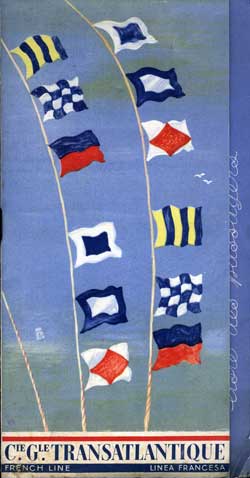
SS Champlain Archival Collection
Champlain (1932) French Line Ship's History (Brief); Passenger Lists; Brochures; Photographs; Sailing Schedules; Advertisements; Excerpts from Information for Passengers.
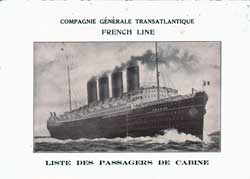
SS Chicago Archival Collection
Chicago (1908) French Line Ship History (Brief); Passenger Lists; Passage Contracts, Tickets, and Receipts; Back Cover Images; Fleet List; Sailing Schedules; Postcards.
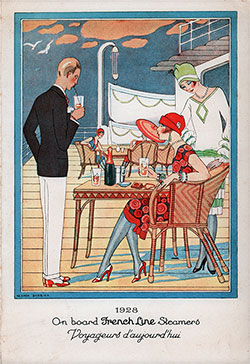
SS De Grasse Archival Collection
De Grasse (1924) French Line Ship's History (Brief), Passenger Lists, Menus, Sailing Schedules, Postcards, Cap Tally (Cap Ribbons), Senior Officers and Staff, Books Referencing the SS De Grasse, Back Cover Images.

SS Flandre Archival Collection
Ephemera for the SS Flandre may include Passenger Lists, Menus, Brochures, Sailing Schedules, Route Maps, Photographs, and more.

SS Espagne Archival Collection
Ephemera for the SS Espagne available may include Passenger Lists, Menus, Brochures, Sailing Schedules, Route Maps, Photographs, and more.
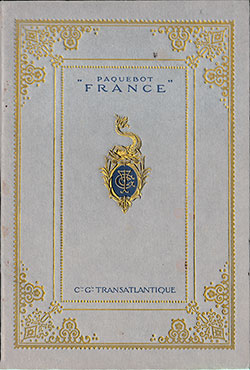
France (1867) National Line (British) Ship's History (Brief); France (1912) French Line Ship's History (Brief); France (1961) French line Ship's History (Brief); Passenger Lists; Brochures; Programs; Sailing Schedules; Title Pages; Senior Officers and Staff; Route Maps, Track Charts, Abstract of Logs; Back Cover Images; Fleet List; Illustrations and Paintings; Photographs; Excerpts from Information for Passengers; Postcards; Advertisements; The Steamship "France" of the French Line - 1912; Books Referencing the SS France.
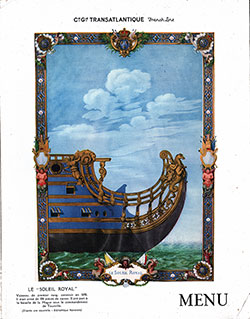
SS Ile De France Archival Collection
Ile de France (1926) French Line, Passenger Lists, Brochures, Deck Plans, Programs, Menus, Other Ephemera, Senior Officers and Staff, Photographs, Sailing Schedules, Cap Tally (Cap Ribbons), Books, Launching of the Ile de France at St Nazaire, 14 March 1926, The SS Ile de France - A Brief History.

SS L'Aquitaine Archival Collection
Ephemera for the SS L'Aquitaine available may include Passenger Lists, Menus, Brochures, Sailing Schedules, Route Maps, Photographs, and more.

SS La Bourgogne Archival Collection
Ephemera for the SS La Bourgogne available may include Passenger Lists, Menus, Brochures, Sailing Schedules, Route Maps, Photographs, and more.

SS La Bretagne Archival Collection
Ephemera for the SS La Bretagne are available at the GG Archives, including Passenger Lists, and other Ephemera.

SS La Champagne Archival Collection
Ephemera for the SS La Champagne available may include Passenger Lists, Menus, Brochures, Sailing Schedules, Route Maps, Photographs, and more.

SS La Gascogne Archival Collection
Ephemera for the SS La Gascogne are available at the GG Archives, including Passenger Lists, Menus, Brochures, Event Programs, and more.
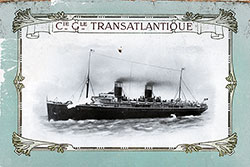
SS La Lorraine Archival Collection
La Lorraine (1899) French Line Ship's History (Brief); Passenger Lists; Menus; Books Referencing the SS La Lorraine.

SS La Normandie Archival Collection
Ephemera for the SS La Normandie available may include Passenger Lists, Menus, Brochures, Sailing Schedules, Route Maps, Photographs, and more.

SS La Savoie Archival Collection
Ephemera for the SS La Savoie available may include Passenger Lists, Menus, Brochures, Sailing Schedules, Route Maps, Photographs, and more.
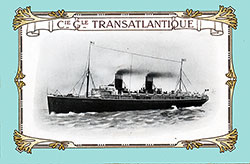
SS La Touraine Archival Collection
La Touraine (1891) French Line Ship's History (Brief); Passenger Lists; Menus; Title Pages; Senior Officers and Staff; Route Maps, Track Charts, Abstract of Logs; Fleet List; Back Cover Images; Other Ephemera; Photographs; Postcards; Books Referencing the SS La Touraine.

SS Lafayette Archival Collection
Lafayette (1915) French Line Ship's History (Brief); Lafayette (1930) French Line Ship's History (Brief); Passenger Lists; Brochures; Sailing Schedules; Title Pages; Senior Officers and Staff; Route Maps, Track Charts, Abstract of Logs; Back Cover Images; Photographs; Services; Fleet List; Books Referencing the SS Lafayette.

SS Liberté Archival Collection
Ephemera for the SS Liberté available may include Passenger Lists, Menus, Brochures, Sailing Schedules, Route Maps, Photographs, and more.
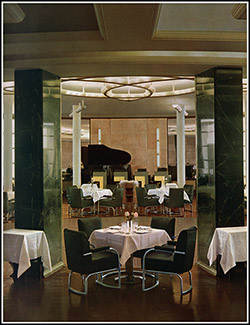
SS Normandie Archival Collection
Normandie (1935) French Line Ship's History (Brief); History of the SS Normandie - 1947; Photographs; Brochures; Passenger Lists; Menus; Immigrant Documents; Books Referencing the SS Normandie; Sailing Schedules; Postcards.

Paris (1889) American Line Ship History (Brief); Paris (1921) French Line Ship History (Brief); Passenger Lists; Brochures; Sailing Schedules; Route Maps, Track Charts, Abstract of Logs; Excerpts from Information for Passengers; Back Cover Images; Services; Fleet List; Photographs; Books Referencing the SS Paris.

SS Rochambeau Archival Collection
Ephemera for the SS Rochambeau available may include Passenger Lists, Menus, Brochures, Sailing Schedules, Route Maps, Photographs, and more.
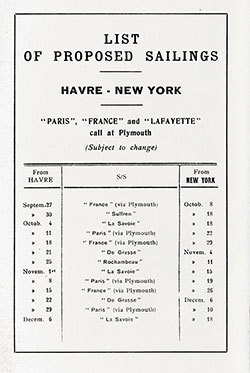
SS Suffren Archival Collection
Ephemera for the SS Suffren available may include Passenger Lists, Menus, Brochures, Sailing Schedules, Route Maps, Photographs, and more.
Return to Content Links
Many of our brochures cover one ship only and can be found through the vessels listed in the first section. Below are brochures that cover the French Line or Multiple Ships.

1938 - Third Class on the French Line
The Normandie, Ile de France, Paris, Champlain and Lafayette combine economy and efficiency in fulfilling the most discriminating requirements. Their Third Class accommodations cannot help but bring you all satisfaction.
Return to Content Links
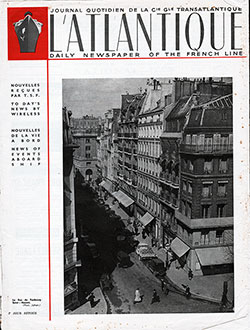
1939-07-14 L'Atlantique - Daily Newspaper of the French Line
The 14 July 1939 Issue of L'Atlantique offers 16 pages of general interest news for the passengers of the SS Normandie, commanded by Captain E. Payen de la Garanderie. Featured articles include Britain Orders Navy to Near War Strength, 75 Années de Relations Transatlantiques, Monsieur Jean Marie, Président de la Compagnie Génerale Transatlantique, Joan of Arc Castle Being Excavated, Le Faubourg St Honoré Shopping and Tour Guide, Deauville - La Plage Fleurie.

1939-07-16 L'Atlantique - Daily Newspaper of the French Line
The 16 July 1939 Issue of L'Atlantique offers 16 pages of general interest news for the passengers of the SS Normandie, commanded by Captain E. Payen de la Garanderie. Featured articles include WPA Strike Crisis Continues, Principal Events for August in France, Ships News, and French Ports of the Mediterranean. In English and French.
Return to Content Links

Christie's Ocean Liner Auction Catalog - 2007
The Christie's Ocean Liner Auction Catalog 2007 included Posters, Ship Models, and Decorative Arts. The provenance of the Items was sourced from The Estate of Wayne LaPoe, The Kenneth C. Schultz Collection, The Jan J. Loeff Collection, The Marcello Collection, and The Collection of Terrence G. O'Connor.
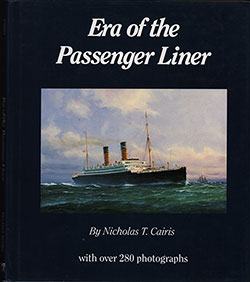
Era of the Passenger Liner - 1992
The Gilded Era comes back to life as the reader relives the careers of stately ships and express greyhounds from immigrant ships to floating palaces. Scarce, large format book containing 288pp. Features photographs, statistics, and background of 280 passenger liners, each with a picture.

The Great Liners: The Seafarers, Volume 4
A history of the world's famous luxury liners provides portraits of the ships. It examines such great disasters as the sinking of the Titanic. This edition explores the grand hotels that traversed the Atlantic between 1840 and 1930.

1997 - Le Havre - New York: French Line
This volume about the French Line and its route from Le Havre to New York is a witness to crossing the Atlantic, from before WWI to the present day. A fascinating visual record of travel.
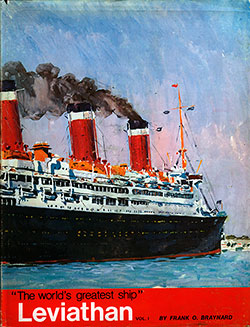
Leviathan: "The World's Greatest Ship" Volume 1
The first volume takes us from the construction of the VATERLAND to the end of World War One when the VATERLAND, now the U.S.S Leviathan, was used as a troop transport and packed with fabulous photographs and reproductions of newspaper articles.
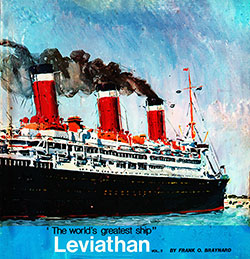
Leviathan: "The World's Greatest Ship" Volume 2
Volume 2 picks up the LEVIATHAN saga during her monumental conversion from a troop ship to a luxury liner and carries the ship’s tempestuous life up through her first round trip as a U.S. express liner. The book finishes with the SS Leviathan's triumphant return to the Atlantic.

Morton Allan Directory of European Passenger Steamship Arrivals
This directory provides a ready means of ascertaining information that will be helpful, for it is arranged by year and steamship company, and there under by port of entry, the vessel name, its arrival date and port of embarkation.

This book recreates the ambiance of the ocean linereraby showing the actual objects used on board. Each piece of ocean-liner memorabilia is like an aladdin's lamp, releasing wondrous memories of that grand style of travel.

Ocean Liners - Precursors, Apotheosis, Post War
Ocean Liners is a detailed look at nearly fifty fabulous ships that have provided pleasure, practicality, and fascination since the beginning of the century.

Passenger Ships of the World - 1963
Passenger Ships of the World, 1963, represents an incredible resource covering passenger ships that are Trans-Atlantic, Trans-Pacific, Trans-Pacific via Panama Canal, Latin American, Africa and the Eastern Oceans, and California-Hawaii.

Picture History of the French Line
This impressive pictorial reference, by noted maritime historian William H. Miller, Jr., includes a wealth of vintage photographs celebrating the legendary French Line.

Sailing Seven Seas: History of the Canadian Pacific Line
With a witty and informative style, author Peter Pigott evokes-not only the nostalgic heyday of ocean travel but reveals a slice of almost-forgotten Canadiana.
Return to Content Links
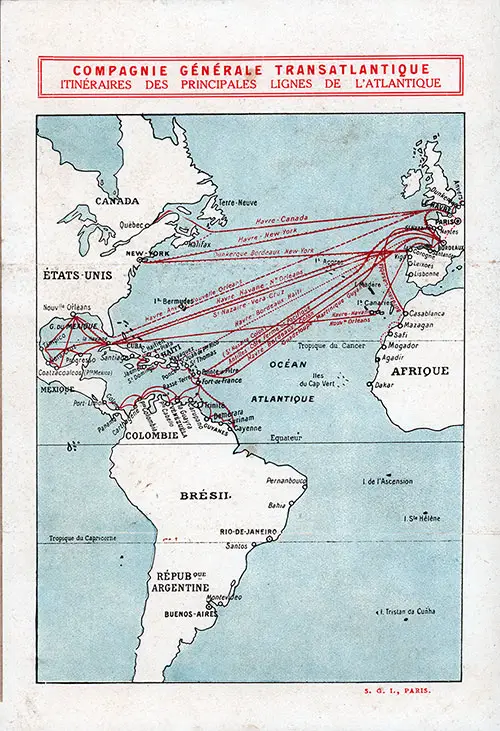
Track Chart on the Back Cover of a 3 February 1918 Cabin Class Passenger List for the SS Rochambeau of the CGT French Line. GGA Image ID # 15c8a2e4a2
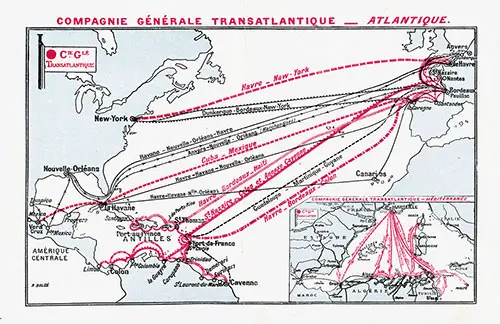
Back Cover - CGT French Line Atlantic Ocean Track Chart from a Cabin Class Passenger List for the SS Rochambeau of the French Line. The Ship Departed 11 June 1919 From Le Havre to New York. GGA Image ID # 15789d9dd2
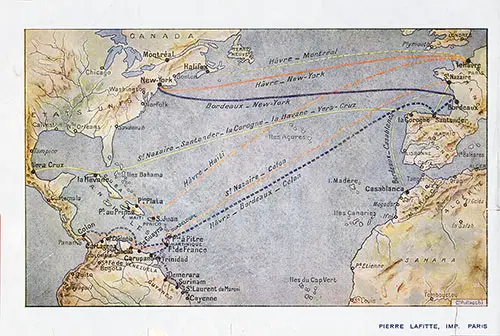
CGT French Line Route Map by Pierre Lafitte, Paris, Showing the Transatlantic Routes Used by Steamships in 1921. From the Back Cover of the SS France Passenger List for 3 October 1921. GGA Image ID # 157af09769
Return to Content Links
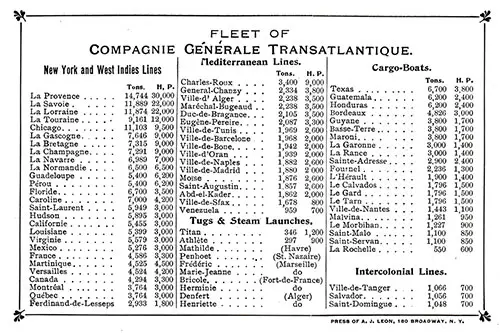
Fleet List, CGT French Line July 1909. GGA Image ID # 12dff9550e
Return to Content Links
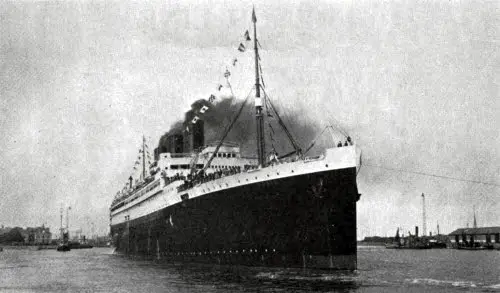
The SS Paris Is the Finest Ship in the French Line Fleet. She Is 768 Feet Long, 86 Feet Wide, and 60 Feet Deep. Her Four Turbines Develop 46,000 Shaft Horsepower. She Can Accommodate 3,240 Passengers and Has a Complement of 664. Shipping Magazine, 10 July 1921. GGA Image ID # 2145b5f86a
FOUNDED IN 185S, as the Compagnie Generate Maritime, the French Line began business with sailing craft to the Newfoundland fisheries and In the guano trade to the Pacific and with steamers from France to Algiers and other ports to the southward.
Six years later the company assumed its present name of Compagnie Generate Transatlantique and made a contract with the French Government to put in operation a line of mail steamers between France and the West Indies, Mexico and the United States.
The first sailing of the new service was by the steamer Louisiane, which left St. Nazaire on April 14, 1862, for Vera Crux. The Havre-New York service was begun with Iron side-wheelers of 3.200 tons. They were 343 feet long. 43 feet beam and 30 feet deep.
Their engines developed from 2,800 to 3,300 horsepower and their speed about 13 knots. For their day, they were fast vessels. The new line was inaugurated with the Bulling of the Washington on June 15, 1861.
She was commanded by Captain Duchesne and arrived in New York on the night of June 28-29. On her first voyage East bound, she left New York on July 6 and arrived at Havre on July 17th, an eleven day trip.
The Lafayette followed her on the line later in the year, leaving Havre on August 24 and reaching New York on September 5, a trip of a little over eleven days and a fast passage for that time.
These two pioneers were followed by the Iron side-wheelers Imperatrice Eugenie, Europe and Napoleon III. This ship was longer and finer lined than her predecessors, being 375 feet long. 46 feet beam, 33 feet deep, and of 3,500 tons. Her engines were rated at 1,860 horsepower and developed 3,570 giving a speed of 13.12 knots.
She was the last puddle steamer built for transatlantic service. She continued on the line until 1872, when she was lengthened, changed from a paddle ship to a screw vessel, and renamed Ville du Havre.
The Perefre. Ville de Paris and St. Laurent were single screw vessels and were fast craft for their day. Their success led the company to abandon side-wheelers and build screw steamers so a fleet of fine single screw ships came into being.
They were named France, Amerique, Labrador and Canada. La Normandie was added to the line In 1883 and marked a distinct advance in size, speed and comfort.
In those days, the greater part of the world's mercantile tonnage was built in the shipyards of Great Britain, French yards being mainly devoted to the construction of men-of-war.
The Compagnie Generate Transatlantique, however, with characteristic progressiveness, decided to establish its own shipyard and build its own liners laid down 188 to only two.
La Gascogne and La Bourgogne were built In the United Kingdom, the others. La Champagne and La Bretagne, being constructed at the company's own works at St. Nazaire.
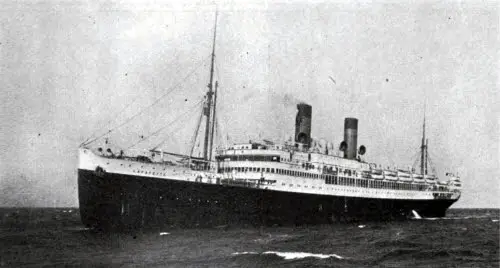
The Lafayette, Launched in 1915, Is a Handsome, Modern Vessel in Service Between Le Havre and New York. Shipping Magazine, 10 July 1921. GGA Image ID # 2145c78f40
These ships were large craft for their day, being 495 feet long. 52 feet beam, 33 feet 6 inches deep and 6,900 tons. Their engines were three-crank six-cylinder compound, each high pressure cylinder being over Its low pressure cylinder, so that there were really three tandem compound engines on the same three throw crank shaft.
For many years, these five ships were favorites with the travelling public. They made some fast passages, too, as the record shows.
Consider these figures.
Westbound, from Havre to New York: in 1886.
- La Normandie: 8 days 3 hours, and three trips In 8 days 5 hours;
- La Bourgogne: 8 days. 7 days 20 hours. 7 days 12 hours;
- La Champagne: S days, two trips in 7 days 21 hours;
- La. Gascogne: 5 days ;
- La Bretagne: 8 days 7 hours. 8 days 2 hours. S days. 7 days 22 hours. 7 days 23 hours.
East bound, from New York to Havre:
- La Champagne: 7 days 23 hours. 7 days 16 hours. 7 days 12 hours. 7 days 19 hours, (twice) 7 days 14 hours. 7 days 18 hours;
- La Bourgogne: 7 days 14 hours (twice), 7 days 17 hours (twice) 7 days 13 hours;
- La Champagne: 7 days 16 hours, 7 days 12 hours, 7 days 19 hours (twice). 7 days 14 hours. 7 days 18 hours:
- La Bretagne: 7 days IS hours. 8 days 2 hours, 7 days 19 hours. 7 days 15 hours;
- La Normandie: 8 days 5 hours (twice); La Gascogne. 7 days 17 hours. 8 days.
Taken from March to December, inclusive, this shows consistent running of a fleet of fine, fast vessels.
But naval architecture progresses constantly, and last year's cracks drop astern as new ships come out. In a few years, these favorite vessels were being out built.
The Company thereupon brought out their first twin-screw ship, La Touraine. She was built at St. Nazaire In 1891 and is still in service. She is 520 feet long, 56 feet beam, 34 feet 6 Inches deep. She is a fine vessel and for years, she has maintained an average sea speed of 19 knots—quite an accomplishment!
She was the first ship with pole masts, previous vessels having been rigged with yards and sails. She was also the first ship to make long cruises, making a tour of the Mediterranean with a full passenger list.
In 1899, the Normannia, built for the Hamburg America Line, was bought from the Spanish Government, which had purchased her Just before the war for use as a transport and auxiliary cruiser. She was renamed L'Aqultaine and put on the New York run.
Two new ships, La Lorraine and La Savoie, followed her. They were 582 feet long. 60 feet beam, 45 feet deep, 15.410 tons displacement and 12,000 tons register. Their engines indicated 22.000 horsepower. La Lorraine began her first trip on August 31. 1901 and La Savoie on September 6. 1902.
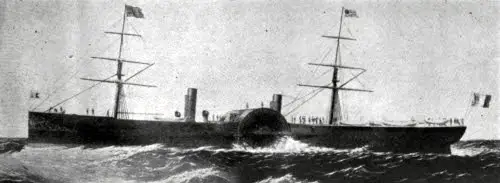
The Napoleon III, Built in 1865, Was One of the Early Ships on the Havre-New York Run. She Was 375 Feet Long and of 3,500 Tons. She Was Lengthened in 1872, Converted to a Screw Ship, and Named Ville Du Havre. GGA Image ID # 2145d2b69a
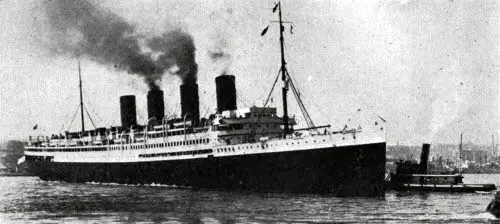
The SS France Is One of the Finest Vessels Ever Built in a French Shipyard, and It Is Surpassed Only by Paris. She Is 732 Feet Long and 21,839 Tons. Her Four Turbines Develop 27,192 Horsepower and Give Her a Sustained Sea Speed of Over 23 Knots. GGA Image ID # 2145eedbc5
Increasing traffic required newer and larger vessels, and the French Line, keeping pace with the demands of travelers. In 1906 added another fine ship, La Provence. She was a twin-screw ship of 18,000 tons and her engines developed 22.000 horsepower.
She went into service in the spring of 1906, leaving Havre the morning of April 21. She arrived In New York on the morning of April 27, making the voyage, allowing for the five hours difference of longitude, In 6 days, 3 hours 24 minutes.
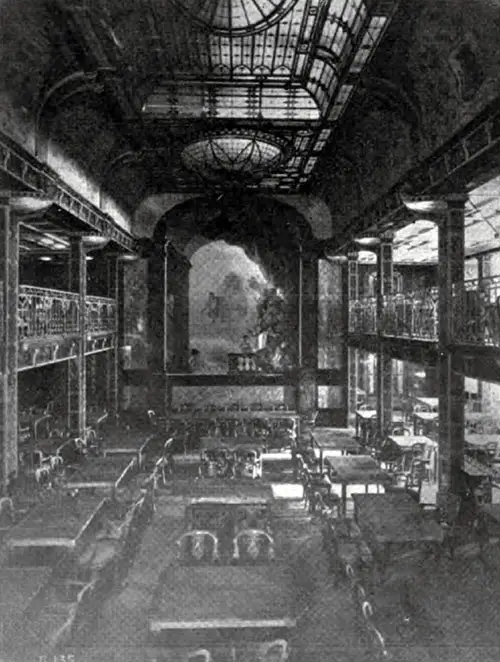
The First Cabin Dining Saloon of the SS Paris Is a Lofty Room, Three Decks High, Seating 500. the Decorations Are Handsome, and the Color Scheme Is Pleasing. GGA Image ID # 21463e228d
Continuing its building program, the company constructed the Rochambeau in 1911. She is 569 feet long, 64 feet beam, 43 feet deep, 13.391 tons register and 17,417 tons displacement on 26 feet 10 Inches draught.
Her engines Indicate 13.000 horsepower and are a combination of reciprocating engines and low-pressure turbines. She is a one-class cabin steamer and is one of the best of that type afloat.
Other one-class cabin steamers are the Chicago, built In 1908, the Niagara, built In the same year and originally used for long cruises, and the older La Touraine.
The next year, 1912, the company placed in service the large quadruple screw steamer France. Though eclipsed by the Paris, the latest addition to the fleet, site was then the finest steamship ever built In a French shipyard. She Is 732 feet long, 7.6 feet beam, 24,839 tons register.
Her four turbines develop 27,192 horsepower. On her maiden voyage, she left Havre April 20, 1912, at 2 p. m. and arrived in New York at 8 a. m. on April 26, making the voyage in 5 days, 20 hours and 2 minutes. Her great size permitted the Incorporation of features not possible on earlier and smaller ships, and spaciousness is a feature of the ship.
But the finest ship of the fleet Is the latest addition, the Paris. She is 768 feet long, 86 feet beam and 60 feet deep. On 31 feet draught, she displaces 36,700 metric tons. Construction was begun before the war, but suspended in 1916 and not resumed until after the armistice. She was built by the Chantier de Penhoet of the Societe des Cbautiers et Ateliers of Saint Nazaire.
Great attention has been paid to the safety of the ship, and she Is divided Into 15 watertight compartments. Forward and aft, the bulkheads extend up to D deck and amid-ships to E deck. Her 15 oil-burning boilers are in five compartments with longitudinal bulkheads outboard and these bulkheads extend aft through the engine room.
Powerful pumps are provided to take care of any incoming water and, should the vessel take a list from damage to a side compartment, water ballast can quickly be pumped to the high side to put her again on an even keel.
Designed originally to burn coal, it was decided in 1920 to make her an oil burner, and she carriers 6,161 metric tons of fuel oil In double bottom and special tanks.
She has 15 double ended 8 furnace Scotch boilers, 17 feet 8 Inches diameter and 27 feet 5 Inches long, designed for a working pressure of 215 pounds and with a total heating surface of 37.620 square feet. They bum oil on the Howden system. All oil piping is in duplicate and any section may be Isolated.
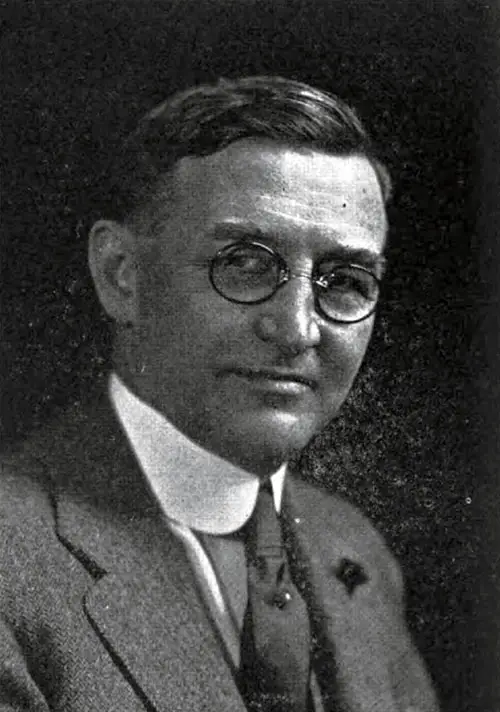
Arthur T. Henderson, Passenger and Traffic Manager, has been associated with the French line since 1892. Photo by Underwood and Underwood. GGA Image ID # 214692840c
The four Parsons turbines develop 46,000 shaft horsepower and drive four propellers. The high pressure and intermediate pressure turbines are outboard, one on each side in separate compartments, and the two low-pressure elements are side by side In the large engine room amidships.
These two are used for maneuvering and the arrangement of valves and gear is ingenious. This plan was used first in the France and later In the Aquitania, Berengaria (ex-Imperator) and Leviathan (ex-Vaderland).
Abaft the engine room is a compartment containing the electric plant, three turbo generators of 450 KW each and a group of reserve sets of 60 KW each driven by oil engines.
(There is also a set of this type on the boat deck, just abaft the chart house, for emergency use with the radio). The compartment also contains feed water heaters, evaporators, filters, pumps and other auxiliaries. Further aft Is the refrigerating machinery, in a compartment of its own.
The Paris has accommodations for 3,240 passengers divided as follows:
- In the staterooms and suites deluxe. 104:
- In the first cabin. 418;
- in the so-called "mixed" class. 50.
- in the second cabin, 464;
- in the third class. 2,200, of whom 1,092 are in staterooms and the rest in bunks.
The ship's complement Is 664, so that there Is a total of 3,904 persons aboard when she is full. Forty-nine 30-foot boats of two different types are Installed, as well as a powerful 30-foot motor launch equipped with radio. In addition, there are 8 rafts of special type and a whaleboat and a dinghy. Wellin quadrant davits permit the rapid launching of all boats.
A powerful radio system keeps the Paris in constant communication with the shore and with other ships, while her submarine signal apparatus makes navigation in fog and easy matter.
The passenger quarters are of great Interest, the public rooms being unusually large and well arranged, and the decorations harmony of color are remarkably beautiful. The joinerwork is fine, rare and handsome woods being used with excellent taste and put together with skilled craftsmanship.
Some of the polished panels of matched veneer resemble in design and beauty rare old bookbinding of tree calf. The general coloring is light and cheerful and the harmony of carpets, bulkheads, hangings, upholstery and furniture Is superb. Wrought Iron Is skillfully used in stair rails, and fabric, of exactly the right shade, softens the light of the dome skylights.
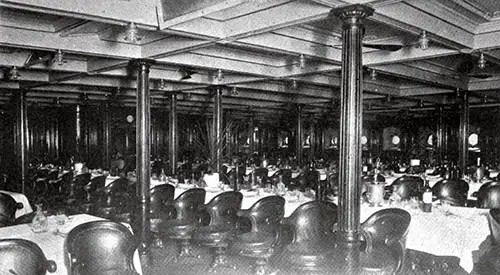
The First Cabin Dining Saloon of SS La Savoie. Compare This Room—Luxurious for the Period—With the Dining Saloon of the SS Paris and See the Advance Made in Less Than Twenty Years. GGA Image ID # 2147708783
The lighting fixtures are all of special design and are very handsome. Here and there are paintings, notably one typifying the city of Paris which covers one bulkhead of the dining saloon. There are no bunks in the first cabin quarters, but handsome beds.
Some of the beds in the deluxe staterooms are fit for exhibition in any museum. In these rooms, too, is displayed the skill of the French artists responsible for the decorations, for there is no stereotyped repetition but each room is given its own treatment and has its own color scheme. The headroom is ample and the passages are wide, giving a feeling of spaciousness everywhere.
The first cabin public rooms are notable, being large und lofty and beautifully decorated. The main saloon or. as the owners call it, the "Grand Salon de Conversation." is a huge room. It is 75 feet long. 45 feet wide and 21 feet headroom, and even with this great width, there are wide decks out-board. By a clever arrangement of plan and furniture, this great room has many nooks and corners giving privacy to those who desire it.
The library and reading room adjoins the main saloon.
With Its panels of sycamore. It Is a handsome apartment. The main saloon opens 011 the main stairway, which is double and three decks high, with an attractive hall at the lower level. Further aft is another saloon, as large as the main saloon, decorated in the Directo Ire style.
Buffet, Café and smoking room adjoin each other on two decks and are large, bright and cheerful rooms, paneled with polished oak and rare woods, with a dome skylight over-head. The Café Is of the popular "veranda” type, with lattice work outboard.
The first cabin dining saloon Is three decks high in the center, with tables on an Intermediate deck each side. The room accommodates 500. The paneling is of Ceylon lemon wood with colored inlaid work. The lighting scheme gives a warm, golden tint that is delightful.
Forward there is a children’s playroom and a children's dining room and elsewhere are the gymnasium, (lower stand, tourists' bureau, bank, information desk and other features for the comfort of passengers. The first cabin accommodations are all on the upper decks B and C and D, A being the boat deck.
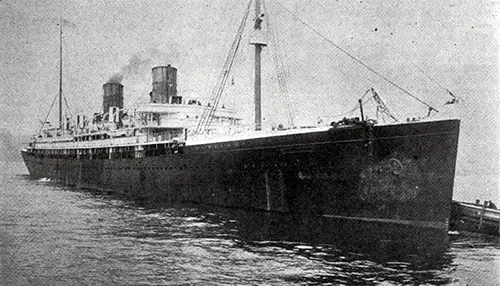
La Touraine Was the French Line’s First Twin-Screw Vessel and the First to Be Fitted With Pole Masts. Earlier Vessels Were Rigged With Yards and Often Carried Sail All the Way Across the Atlantic. GGA Image ID # 214784ce12
The second cabin quarters are located amidships and aft on five decks. B, C, D. E and F. connected by a large central stairway. The decorations are simpler and plainer than those of the first cabin quarters, but are in good taste and remarkably pleasing.
The dining saloon located on Deck E, seats 272, and has an area of 1,330 square feet. It runs the full width of the ship and is a good-looking room. The second cabin saloon and the smoking rooms are good sized and neatly paneled and the decorations are In excellent taste.
The second cabin state rooms are fitted with one, two and four berths to a room. Ample deck space is assigned to the second cabin passengers.
The third cabin accommodations of the ship have been planned in the modern style, nearly half of the berths being in staterooms for two or four passengers. There are three dining rooms, and ample covered deck space Is allotted to those who travel third class.
Altogether, the Paris is a notable ship and a credit to her designers, owners and builders.
Few realize that the Compagnie Generate Transatlantique owns a fleet of vessels, which, excluding tugs and ships under construction, numbers 93. The names of these ships and the year in which each was built are as follows on the New York line:
- Paris, 1921;
- France. 1912;
- La Savoie, 1901,
- La Lorraine. 1900;
- Suffren. (building);
- Lafayette. 1915:
- Rochumbeau. 1911;
- Lu Touraine, 1S91;
- Chicago. 1908;
- Niagara. 1908;
- Roussillon. 1906;
- Labourdonnais. 1904.
On the Dantzic passenger service (a “feeder” line):
- Pologne, 1911.
Passenger liners to Mexico and the West Indies:
- Espagne. 1910;
- Colombie. (building);
- La Navarre. 1893;
- Flandre. 1914;
- Perou. 1908;
- Puerto Rico. 1914:
- Haiti. 1914;
- Macoris, 1902;
- Martinique. 1883.
Combination passenger and freight steamers to New York. Mexico and the West Indies:
- De la Salle, (building);
- Caroline. 1908;
- Missouri. 1920;
- Kentucky. 1921;
- Hudson. 1905;
- Callfornte. 1905;
- Virginia, 1903;
- Mexico. 1905;
- Caravelle. 1904.
Freighters to New York. Mexico and the West Indies:
- JacquesCartier, 1918;
- Alaska, (building);
- Alabama, (building);
- Arizona, (building);
- Montana. 1903;
- Ontario. 1919;
- Maryland. 1919;
- Texas. 1908;
- Mississippi. 1913;
- Georgie. 1913;
- Michigan. 1920;
- Lamentin, 1895;
- Carbet. 1920;
- Vauclin, 1903;
- Mont-Vontoux. 1904;
- La Drome. 1900;
- Caralbe, 1906;
- Guyane. 1908;
- Basse-Terre. 1909;
- Cantal. 1916.
Freighters to the Pacific:
- Honduras, 1909;
- Salnt-Andre. 1912;
- Salnt-Joseph. 1912;
- Salnt-Louls. 1913;
- Salnt-John, 1915.
Passenger ships of the Bordeaux-Casablanca Line:
- Volubllis. 1902;
- Figuig, 1903.
Havre-Cardiff service:
- Saint-Adresse, 1908;
- Gravllle. 1919.
Passenger ships in the West Indies:
- Antilles, 1913;
- Saint-Haphael. 1908.
Freighters In the West Indies (feeder lines):
- Taza. 1904;
- Matoaba. 1908;
- Marie Galante, 1906;
- Batata. 1892;
- Esperanto. 1906.
Freight and passenger steamers In the Mediterranean:
- Timgad. 1911;
- Charles-Roux. 1909;
- Lamoriciere. 1921;
- Due d'Aumale, 1913;
- VIlle-d’Alger. 1890;
- Marechal-Bugeaud, 1890;
- Duc-de-Bragance. 1889;
- Eugene-Perelre, 18S8;
- Ville-de-Tunis. 1881;
- Abd-el-Kader. 1880;
- Oudjda. 1881;
- Ville-de-Madrid. 1880;
- Vllle-d’Oran. 1880;
- VIlle-do-Bone. 1880;
- Moise, 1880;
- La NIevre. 1881;
- Biskra, 1915;
- Jeanne-d’Arc. 1883.
Freighters in coastwise service:
- Somme. 1897;
- Ardeche. 1890;
- La Garonne. 1906;
- Lozere, 1910;
- Gatinais. 1907;
- Olse. 1919;
- Orne, 1919;
- Aube. 1896;
- Vllle-de-Nantes. 1884;
- Saint-Servan, 1906;
- Vaucluse. 1906;
- Le Morbihan. 1887;
- Capitaine-Coullon. 1917;
- La Rochelle. 1906.
Tugs:
- Athlete. 1890;
- Titan. 1889.
The company maintains services between France and New York, Baltimore, Philadelphia. Cuba. Mexico, New Orleans. Panama. Guiana, Haiti. Porto Rico and other West Indian ports; Hamburg. Antwerp. Cardiff, London and Liverpool; Casa Blanca. Algiers, Tunis, Oran. Bone. Phlllippeville, Blzerte, Mazagan, Saffl; Mogador. Tangier. Sfax. Cette, Bougie, Montaganem, Christohal, Guayaquil, Callao, Mollendo, Arica Iquique, Antofagasta, Valparaiso and Talcahuano.
Charles H. Hall, “the Compagnie Générale Transatlantique Is One of the World’s Great Ship-Owners” in the Shipping Magazine: Marine Transportation, Construction, Equipment and Supplies, New York: Shipping Publishing Co. Inc, Vol. 14, No. 1, July 10, 1921, p. 11-17.
Return to Content Links
